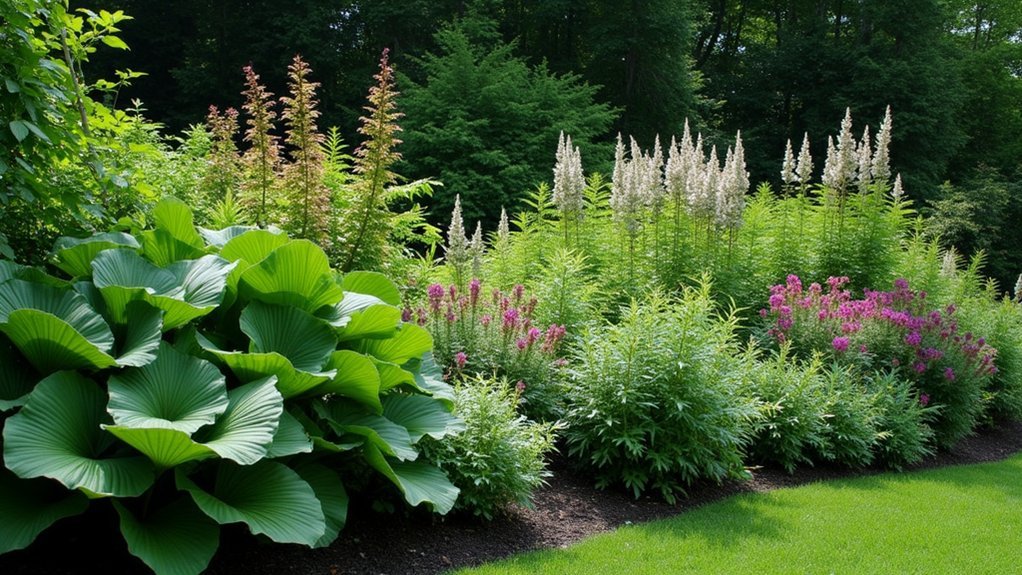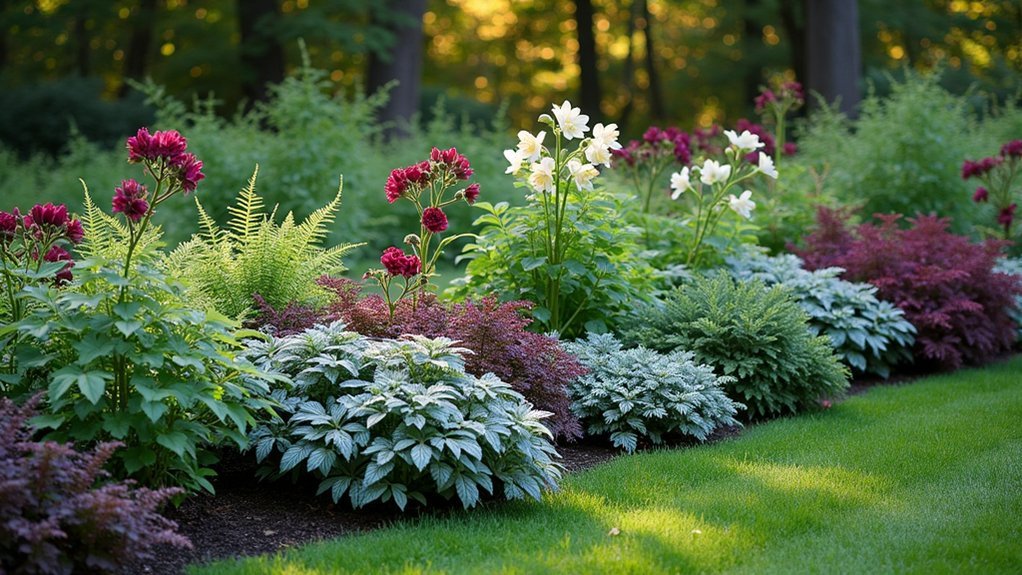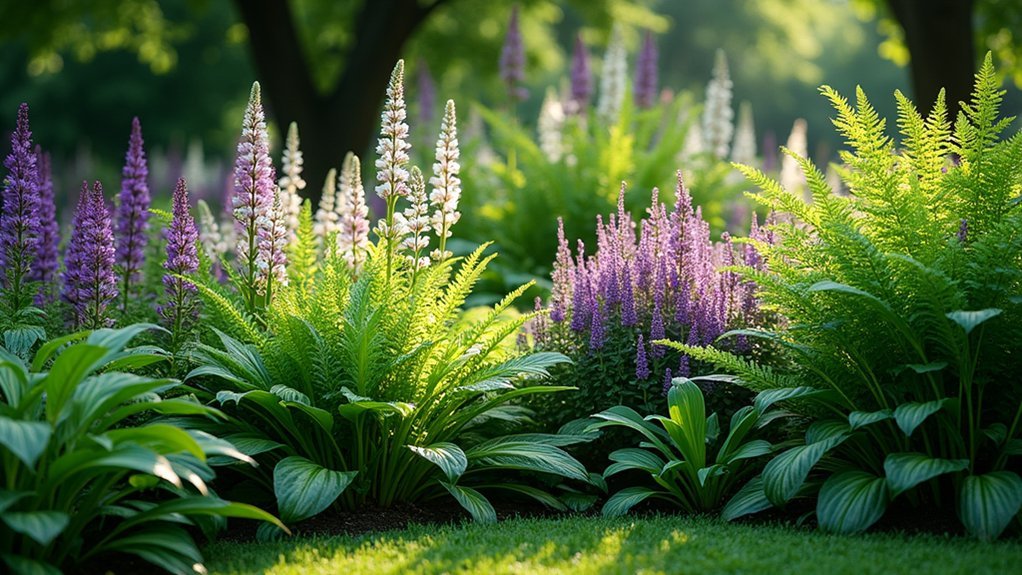Creating stunning shade borders requires strategic layering with plants that thrive in low light. Start with structural evergreens like Buxus ‘Sprinter’, add mid-height perennials such as Coral Bells for seasonal color, and finish with ground covers like Lamium to suppress weeds. Don’t forget vertical interest from climbers like Chinese virginia creeper and textural contrast from ferns paired with bold hostas. These combinations will transform your challenging shady spots into the garden’s most enchanting features.
Creating Depth With Multi-Layered Shade Plantings

While shady spots often present gardening challenges, they offer exceptional opportunities to create enchanting visual depth through thoughtful layering. By combining various leaf shapes, colors, and textures in your shade-loving plants, you’ll build interest that persists throughout the seasons.
Start by positioning taller specimens like ferns or ligularia at the back, then work forward with mid-height plants and finish with low-growing ground covers such as lamium. This arrangement naturally draws the eye through your garden.
Create visual depth by layering – tall plants in back, medium in middle, ground covers in front.
For year-round structure, include evergreens alongside seasonal perennials. Create dynamic contrasts by pairing dark purple coral bells with bright green hostas.
Don’t forget to mix flowering plants like astilbe with foliage-focused varieties such as brunnera – this combination maintains visual interest while attracting pollinators to your multi-layered plantings.
Evergreen Foundation Plants for Year-Round Structure
Your shade garden needn’t become a barren wasteland during winter months when you incorporate evergreen foundation plants that maintain structural interest year-round.
Choose low-maintenance anchors like Buxus ‘Sprinter’ or native Diervilla ‘Kodiak’ Orange to establish permanent borders that frame your seasonal shade plantings.
These reliable workhorses not only provide multi-season foliage interest with minimal upkeep but also create the perfect backdrop for showcasing more ephemeral shade-loving perennials and annuals.
Multi-Season Foliage Interest
Although shade gardens often shine with spring ephemerals, they’ll truly excel year-round when anchored by reliable evergreen foundation plants. Your shady areas can maintain visual appeal throughout all seasons when you incorporate plants with multi-season foliage interest.
| Plant Name | Visual Appeal | Maintenance | Best Feature |
|---|---|---|---|
| Boxwood ‘Sprinter’ | Structured form | Low, deer-resistant | Year-round structure |
| Soft Shield Fern | Feathery texture | Moderate | Vibrant green color |
| Japanese Plum Yew | Dense foliage | Low | Winter hardiness |
| Christmas Fern | Leathery fronds | Minimal | Erosion control |
These shade-loving perennials create textural depth with their varied leaf shapes and forms. By selecting evergreen foundation plants with different heights and growth habits, you’ll create a dynamic planting that looks purposeful and polished even during winter when flowering plants have faded.
Low-Maintenance Border Anchors
Six essential evergreen plants form the backbone of any successful shade garden, providing structure when deciduous plants go dormant.
In shady borders, options like ‘Sprinter’ Buxus microphylla offer remarkable resilience—they’re deer resistant and immune to boxwood blight, making them perfect low-maintenance choices.
You’ll appreciate how soft shield ferns (Polystichum setiferum) contribute lush texture year-round without demanding constant attention.
These evergreen specimens create visual depth even in winter when other plants disappear.
Consider incorporating ground cover varieties to suppress weeds naturally.
They’ll establish a solid foundation layer that requires minimal watering once established.
The varied leaf shapes and colors available among shade-tolerant evergreens allow you to design enchanting borders that maintain their structure and interest throughout all seasons.
Flowering Perennials That Thrive in Low Light

You’ll find that shade gardens can burst with color when you plant perennials like Lamium ‘Chequers,’ Gentiana ‘True Blue,’ and Phlox procumbens ‘Variegata.’
These low-light champions offer vibrant blooms from spring through fall, ensuring your shaded spaces never lack visual interest.
For year-round appeal, combine early-flowering Meehania cordata with summer and autumn bloomers to create a shade garden that delivers continuous color throughout the growing seasons.
Colorful Shade Bloomers
When most gardeners imagine shade gardens, they often picture lush greenery but assume vibrant flowers are impossible.
You’ll be delighted to discover that colorful shade bloomers can transform those dim corners into spectacular displays.
Lamium ‘Chequers’ introduces eye-catching blooms that thrive in low-light spaces, while Gentiana ‘True Blue’ delivers striking azure flowers to your part shade garden.
Don’t overlook Phlox procumbens ‘Variegata’, which combines variegated foliage with delicate flowers for added texture in your shade border.
Meehania cordata offers unique blooms that perform beautifully in partial to full shade conditions.
These perennial flowers prefer rich, moist soil to reach their full potential.
Four-Season Flowering Varieties
Creating a garden that flowers throughout all seasons might seem challenging in shaded areas, yet several exceptional perennials offer continuous visual interest despite limited sunlight.
These four-season flowering varieties guarantee your shady border remains vibrant year-round.
- Lamium ‘Chequers’ produces vibrant blooms that thrive in shade, adding consistent color throughout the growing season.
- Gentiana ‘True Blue’ delivers striking blue flowers that enhance shaded borders with its rich, true-blue color.
- Phlox procumbens ‘Variegata’ offers beautiful variegated foliage and spring flowers, creating multi-dimensional interest.
- Meehania cordata brings unique flowering characteristics to low-light conditions, extending the bloom season.
You’ll discover these perennial shade plants not only survive but flourish where other flowers struggle.
Textural Contrast: Ferns and Broad-Leaved Companions
Few design elements transform a shady garden more effectively than the interplay between delicate ferns and bold, broad-leaved plants. By incorporating evergreen varieties like the soft shield fern (Polystichum setiferum), you’ll enjoy lush greenery year-round in your shade garden.
For maximum textural contrast, pair ferns’ feathery fronds with the large, rippled foliage of hostas. This combination creates visual depth that catches the eye even without flowers.
Try grouping Japanese painted ferns alongside rugged ligularia or complement fern clusters with heuchera and astilbe to create a living tapestry of varying shapes and colors.
This strategic pairing not only maximizes visual interest throughout the growing season but also minimizes maintenance needs. Your shaded borders will maintain their lush, vibrant appearance with these complementary textural companions.
Climbing Plants for Vertical Interest in Shady Boundaries

Many shade gardens lack dimension until vertical elements alter the space. By incorporating climbing plants along your shady boundaries, you’ll create depth and visual interest while maximizing limited growing area.
Chinese virginia creeper (Parthenocissus henryana) thrives in shade, offering lush green foliage that shifts to stunning red in autumn.
- Hydrangea aspera (Villosa Group) provides mauve blooms and requires moist soil in shaded areas
- Chinese fairy bells (Disporum longistylum) work beautifully in mid to back borders with their delicate flowers
- Climbers can serve as natural screens, creating privacy while enhancing aesthetics
- These vertical plants add texture and color, turning bland boundaries into dynamic garden features
You’ll find these climbing options not only solve spatial challenges but also create stunning focal points in otherwise flat garden designs.
Ground Covers for Filling Gaps and Preventing Weeds
While vertical elements add height to shady areas, the ground plane deserves equal attention for a complete garden design. Ground covers like Ajuga reptans and Lamium maculatum excel at filling gaps in shady borders while their dense foliage naturally suppresses weeds.
Don’t overlook the ground plane in shady gardens—thoughtful ground covers create a complete design while naturally controlling weeds.
For challenging dry shade conditions, turn to resilient shade-loving plants such as Carex pensylvanica and Miniature Hosta ‘Mini Skirt’. They’ll thrive where other plants struggle, creating a lush carpet with minimal maintenance.
Options like Saxifraga stolonifera and Meehania cordata not only retain soil moisture but add visual interest through their distinctive foliage.
The colorful Polka Dot Plant and hardy Foamflower deliver vibrant accents while competing successfully with unwanted vegetation for resources. You’ll spend less time weeding and more time enjoying your shade garden’s beauty.
Seasonal Color Changes in Shade-Tolerant Border Plants

Although shade gardens might seem limited in color potential, the right selection of border plants can create a kaleidoscope of changing hues throughout the year.
You’ll find that many shade-tolerant plants offer spectacular seasonal color variations that keep your garden vibrant even in low-light conditions.
- Coral Bells transform from rosy purple in spring to brilliant autumn shades, providing year-round visual interest.
- Early-blooming perennials like Helleborus produce flowers before other plants wake up, giving your shade garden a head start on color.
- Hostas display dramatic foliage changes throughout seasons, ranging from deep greens to vibrant yellows and blues.
- Summer-flowering plants such as Ligularia and Astilbe add pops of color with their bright blooms that contrast beautifully against lush green backgrounds.
Drought-Resistant Options for Dry Shade Challenges
Dry shade presents one of gardening’s most difficult challenges, combining limited sunlight with moisture competition from established trees and structures. Fortunately, several drought-resistant plants thrive in these conditions while adding visual interest to your borders.
| Plant Name | Key Benefit |
|---|---|
| Brilliance Autumn Fern | Colorful foliage in dry shade |
| Carex pensylvanica | Drought-tolerant native grass |
| Hosta ‘Mini Skirt’ | Vibrant miniature variety |
| Saxifraga stolonifera | Striking appearance with minimal water |
| Diervilla ‘Kodiak’ Orange | Native plant with brilliant fall color |
When selecting plants for dry shade areas, always check specific drought tolerance ratings. Native plants like Diervilla often perform exceptionally well, having adapted to local conditions over generations. These resilient options will transform challenging spots into beautiful, low-maintenance border areas.
Frequently Asked Questions
What Is a Shade-Loving Border Plant?
A shade-loving border plant is a perennial or annual that you’ll plant along garden edges where sunlight is limited. They’re specially adapted to thrive in partial to full shade conditions.
What Plants Do Well in Full Shade?
For full shade, you’ll find Astilbe, Toad Lily, Helleborus, Hostas, and Heartleaf Brunnera thrive beautifully. Don’t forget Foamflower and Coral Bells—they’ll add stunning foliage and flowers despite minimal sunlight exposure.
How to Make a Shady Border?
Select shade-loving plants like hostas and ferns. Create layers with taller plants at the back, shorter ones in front. Enrich soil with organic matter and monitor watering needs. Contrast textures and colors for visual interest.
What Are the Best Low Maintenance Border Plants?
For low maintenance border plants, you’ll love hostas, ferns, astilbe, and coral bells. They’re easy to care for, require minimal watering, and naturally suppress weeds. Perennials like foamflower also need little attention once established.
In Summary
Don’t let those shady spots go to waste! You’ve now got a full toolkit of plants to transform any dim corner into a lush, layered border. By combining evergreens for structure, flowering perennials for color, and textural elements for interest, you’ll create dynamic boundaries that evolve throughout the seasons. Remember, even challenging dry shade areas can become thriving garden highlights with the right plant selections.





Leave a Reply